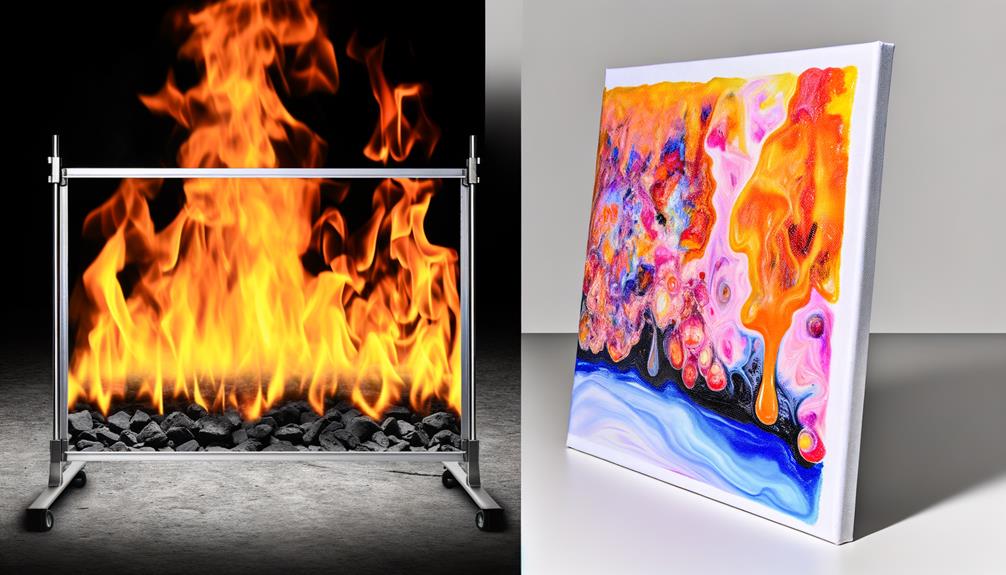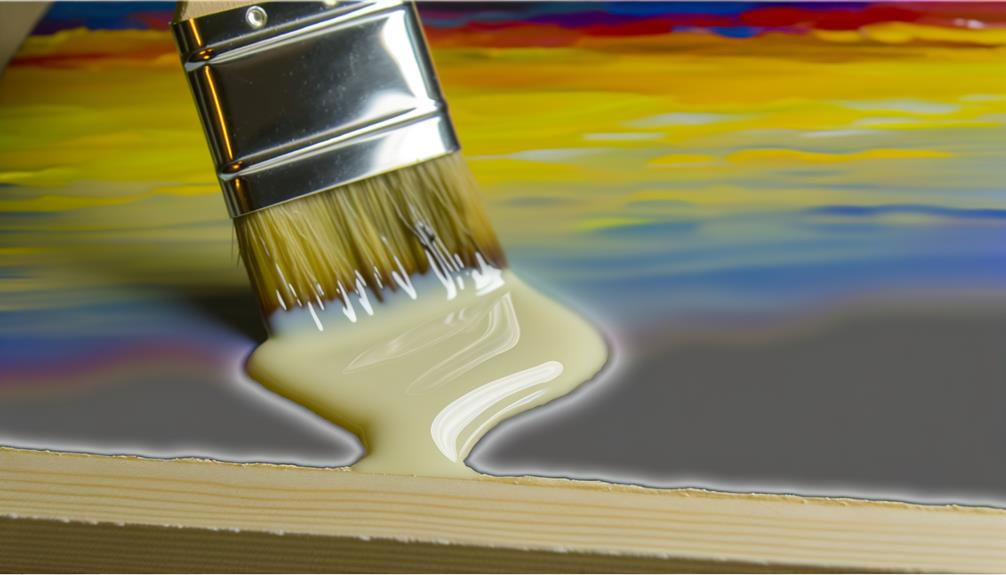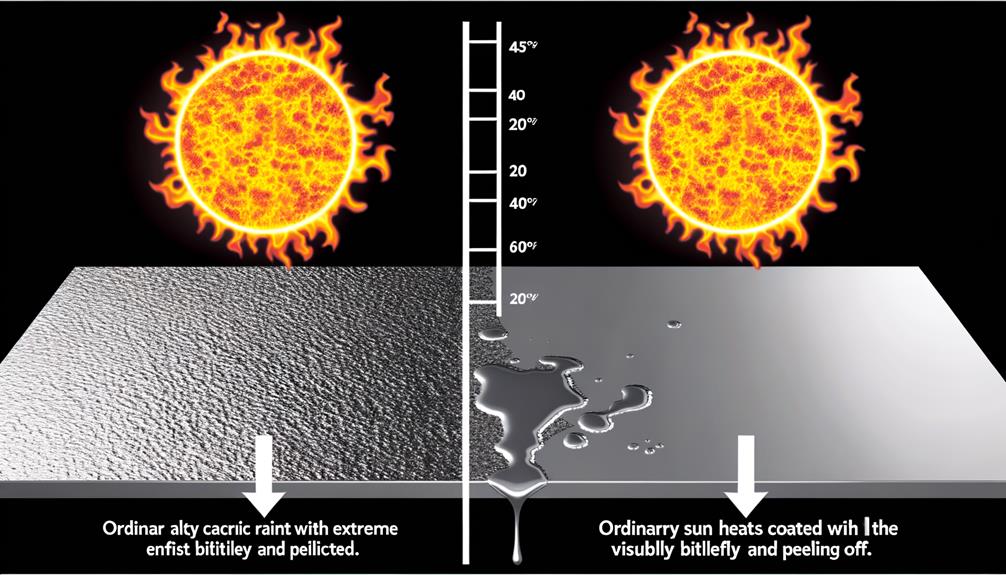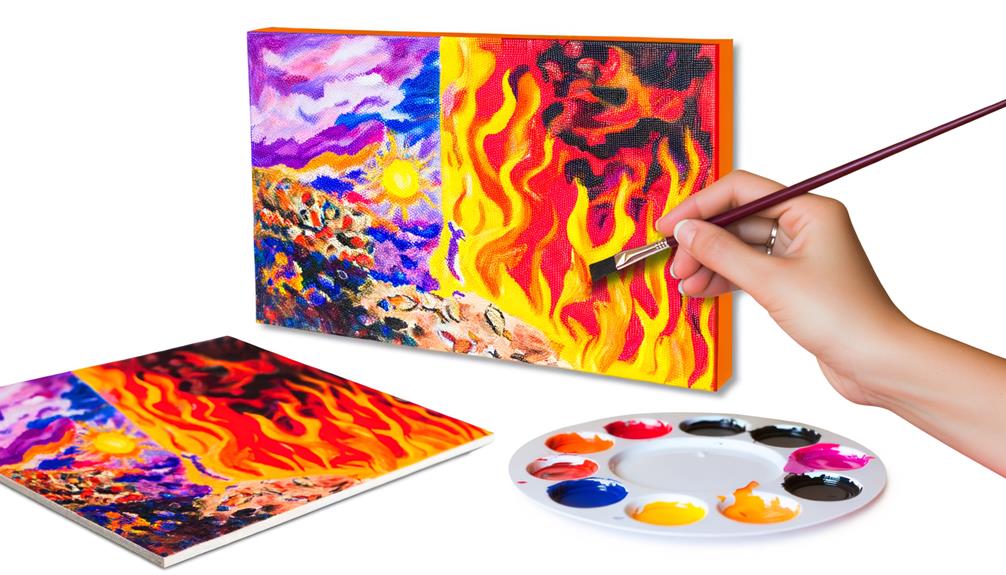We’ve all heard the theory that acrylic paint is heat resistant, but how accurate is this claim? While it’s true that acrylic paint does exhibit some level of heat resistance, the extent of this resistance is the subject of debate.
The ability of acrylic paint to withstand heat primarily depends on the temperature involved. Generally, acrylic paint can handle lower temperatures quite well, but when it comes to higher degrees, that’s where things start to get tricky. Will the paint remain intact or begin to crack and peel?
There’s more to this than meets the eye, so let’s explore further.
Key Takeaways
- Acrylic paint has a safe heat tolerance range of 50 to 80 degrees Fahrenheit, and it can withstand temperatures up to 150 degrees Fahrenheit before softening.
- Primer, heat-resistant additives, varnish, and polyurethane can be used to extend the temperature limit and protect acrylic paint from heat damage.
- Sunlight can cause color fading, cracking, and brittleness in acrylic paint, so it is important to avoid direct sunlight and use UV-protected varnish to prevent fading.
- Acrylic paint’s texture and drying time can be affected by different weather conditions, such as high temperatures making it more malleable and cold weather making it thicker and tougher to spread. Storing acrylic paintings in a moderate heat environment can help preserve their quality during winter months.
Understanding Heat-Resistant Paint

Heat-resistant paint’s unique formulation, typically harnessing resins like polyurethane or epoxy, is made to withstand high temperatures above 26 degrees Celsius, effectively absorbing heat without any alteration in consistency.
This heat resistance is crucial for combating temperature fluctuations and harsh conditions, making these paints suitable for use in dry or high summer areas.
As part of our community, understanding heat-resistant paint is vital. Let’s delve into how to make acrylic paint heat-resistant. Usually, acrylic paint isn’t inherently heat-resistant.
But, by adding heat-resistant mediums, we can increase the heat resistance of acrylic, allowing it to withstand higher temperatures. It’s a useful trick for artisans and DIY enthusiasts alike.
Next, consider the highest temperature that acrylic can handle. Without modification, acrylic paint tends to lose its integrity at around 80 degrees Celsius, but with the right additives, this limit can be extended substantially.
Temperature Tolerance of Acrylic Paint
While we’ve established that acrylic paint isn’t inherently heat-resistant, it’s crucial to understand its specific temperature tolerance, particularly how it behaves under varying degrees of heat.
Acrylic paint has a safe heat tolerance range of 50 to 80 degrees Fahrenheit. Beyond this, acrylics can withstand temperatures up to 150 degrees Fahrenheit before they start to soften.
We’ve created a table to help visualize the temperature that acrylic paint can endure:
| Temperature Range | Acrylic Paint Behavior | Prevention Measures |
|---|---|---|
| 50-80°F | Stable | Store in cool place |
| 80-150°F | Can withstand | Use primer or heat-resistant additives |
| >150°F | Begins to soften | Apply varnish or seal with polyurethane |
To make acrylic paint heat resistant, one can use various methods, including using a primer or adding heat-resistant additives. These steps can help prevent the acrylic paint from catching on fire or fade in direct sunlight.
Acrylic Paint Exposure to Sun

Examining the effects of sunlight on acrylic paint, we find that UV rays can precipitate color fading and induce chemical changes that alter the paint’s consistency. It’s crucial to understand the root causes of this sun-induced fading to better preserve the vibrancy and longevity of acrylic pieces.
Sunlight Effects on Acrylic
When acrylic paint is exposed to sunlight, it can crack and fade over time due to the heat and UV radiation. Exposure to direct sunlight can also lead to color fading and chemical reactions that affect the paint’s consistency.
| Effect | Solution |
|---|---|
| Cracking | Avoid Direct Sunlight |
| Fading | Use UV-protected Varnish |
| Chemical Reactions | Store in Cool Place |
| Brittleness | Use Heat Resistant Acrylic |
Acrylic paintings need to be protected from direct sunlight to prevent these effects. Though not inherently heat resistant, acrylic can withstand temperatures to some extent. However, prolonged exposure makes it brittle and prone to cracking.
A UV-protected varnish can provide additional protection, helping maintain the vibrant colors and smooth texture of our beloved acrylic artworks, even when exposed to sunlight.
Acrylic Paint Fading Causes
Moving from the general impact of sunlight on acrylic paints, let’s take a closer look at the specific causes of fading, primarily due to acrylic paint’s exposure to the sun.
The UV rays in sunlight can cause acrylic paints to fade over time. This fading isn’t only a change in color but also a chemical reaction that alters the consistency of the paint.
When acrylic painting is exposed to direct sunlight, the paint can dry out, become brittle, and even crack in extreme temperatures. This is what we mean when we say ‘Acrylic Paint Melt’. So, how can we make acrylic paint heat-resistant?
Applying a layer of varnish or using heat-resistant additives can help. Remember, the temperature can affect acrylic paint in significant ways, so store your creations properly.
Preventing Sun-Induced Damage
Often, we overlook the potential harm the sun can inflict on our acrylic paintings, but with certain precautions, we can prevent this sun-induced damage and extend the vibrancy and life of our artwork.
Acrylic paint starts melting at high temperatures, so protecting your art from sunlight is key to making your paintings last.
| Measures | Effect |
|---|---|
| UV Protection | Prevents color fading |
| Avoid Direct Sunlight | Prevents chemical reactions |
| Avoid Extreme Heat | Keeps paint consistency |
Acrylic paint is not entirely resistant to heat, so it’s important to ensure it’s not exposed to high heat. This includes avoiding direct sunlight, especially in the first year. By following these steps, we can keep our acrylic paint heat resistant, thus preventing sun-induced damage.
Enhancing Heat Resistance in Acrylic Paint

Increasing the heat resistance of acrylic paint involves the use of heat-resistant additives or specially formulated heat-resistant acrylic paints. These methods allow the paint to withstand heat beyond its typical maximum temperature.
When we discuss enhancing heat resistance in acrylic paint, we’re referring to the process of augmenting the paint’s ability to handle higher heat levels.
Heat-resistant paints are specially formulated to endure temperatures typically above 26 degrees Celsius. Utilizing these paints, or incorporating a heat-resistant additive into standard acrylic paint, can significantly enhance its heat resistance.
Applying an additional layer of varnish or polyurethane, or a heat-resistant primer, can also increase the heat resistance of acrylic paint. These coatings act as a protective barrier, helping the paint withstand heat and preserving its high-quality finish.
To ensure acrylic paint heat resistant properties aren’t compromised, it’s essential the paint is allowed to dry properly. Avoiding exposure to extreme temperatures and direct sunlight during the drying process can help maintain its heat resistance.
Impact of Low Temperatures on Acrylic Paint
As we turn our focus to the impact of low temperatures on acrylic paint, we must consider several key aspects.
Acrylic Paint’s Temperature Sensitivity
Though acrylic paint can withstand lower temperatures, typically below 80 degrees Fahrenheit, it tends to thicken and become challenging to spread when exposed to cold conditions.
This is a key aspect of acrylic paint’s temperature sensitivity. However, it’s not that this type of paint can’t withstand such conditions, it’s just that it reacts differently, like many materials do when temperatures drop significantly.
When we ask, ‘is acrylic paint heat resistant?’, it’s important to consider both low and high temperatures. At high temperatures, acrylic paint doesn’t melt but softens gradually.
This paint can withstand temperatures even above 150 degrees Fahrenheit, but its nature alters. Therefore, while not naturally a heat-resistant paint, it’s adaptable within certain temperature ranges.
Cold Weather’s Effects
When it comes to painting with acrylics in cold weather, we must consider how low temperatures can significantly affect the paint’s texture and usability. The effects of cold weather aren’t to be overlooked as they can make acrylic paint thicker, tougher to spread, and extend its drying time.
This can leave your painting susceptible to dust and debris. Freezing temperatures can also make the paint hard and prone to breakage. So, even if we’re discussing whether acrylic paint is heat resistant, we can’t ignore the impact of low temperatures.
It’s crucial to use different types of acrylic paint within the recommended temperature for an extended period, ideally between 50 and 80 degrees Fahrenheit, to ensure quality results.
Preserving Paint in Winter
Shifting our focus to the impact of cold on acrylic paints, it’s essential to understand how to preserve the quality of the paint during winter months. Low temperatures can cause the paint to become thick and hard to spread. Therefore, storing your paintings in an environment with moderate heat is crucial.
Avoid exposing the acrylic paints to extreme cold or hot temperatures. While latex paints can withstand more heat, they also struggle in the cold.
Here’s a comparison of the paints:
| Paint Type | Heat Resistant at High | Preserving in Winter |
|---|---|---|
| Acrylic | No | Moderate heat needed |
| Latex | Yes | Moderate heat needed |
| Enamel | Yes | Moderate heat needed |
Comparing Tempera, Latex, and Enamel Paints
Diving into a comparison of Tempera, Latex, and Enamel paints, we find that each type exhibits distinct heat resistance capabilities which are crucial to consider in diverse painting scenarios.
Analyzing Tempera Paint Heat resistance, we quickly realize it isn’t as robust as Acrylic Paint Heat Resistant properties. It’s prone to cracking under high temperatures, making it less suitable for tasks demanding heat resistance.
Moving on to Latex Paint Heat resistance, it’s clear this isn’t its strength either. This paint type tends to melt and deform when subjected to high heat, indicating a weakness in standing up to such conditions.
Comparing tempera, latex, and enamel paints, enamel paint displays superior heat resistance. However, it too has its limits. Enamel Heat resistance can falter at higher temperatures, leading to paint breakdown.
In our pursuit to make the paint withstand heat, the type of surface and temperature conditions it will face are key considerations. For surfaces like metals exposed to direct heat or sunlight, paints designed with high heat resistance like epoxy, silicone-based, or urethane-based paints are recommended.
Choosing Heat Resistant Paint for Metal

Selecting Fire-Resistant Paints
When it comes to choosing the right heat-resistant paint for metal, it’s crucial to understand that different metals require specific types of paint. Options like epoxy, silicone-based, and urethane-based paints are typically recommended for surfaces exposed to direct heat, fire, or sunlight.
For temperatures reaching 133 degrees or more, these types of paints prove to be the best heat-resistant paint options.
Before you start, make sure to prepare the surface properly. Temperature fluctuations can impact the paint’s consistency, so it’s essential to apply it in a controlled environment.
Best Practices for Application
Before we delve into the application process, let’s understand that choosing the right heat-resistant paint for metal surfaces largely depends on the quality of the metal and the temperatures it’s likely to face.
We need to avoid water-based paints, including Hot Can Acrylic, as they lack the heat resistance of oil-based paints or those with synthetic rubber.
When applying the paint, it’s critical to follow the instructions carefully. Over-application or under-application can compromise the durability and heat resistance. If you’re painting a surface like Acrylic Nails, it’s best to avoid heat entirely.
Longevity Tips for Acrylic Paintings
Understanding how to enhance the longevity of acrylic paintings requires a careful examination of heat resistance strategies, including the use of primers, additives, and varnishes.
Acrylic paint, made from polymer, isn’t innately heat resistant. It may start melting when exposed to temperatures above 80 degrees Fahrenheit. So, it’s crucial to employ protective measures to prevent this.
One of our primary longevity tips for acrylic paintings involves the use of a primer. This acts as a protective layer, enhancing the paint’s heat resistance. Heat-resistant additives are another option. They’re mixed into the paint, raising its melting point. Alternatively, a heat-resistant varnish can be applied after the paint has dried, offering a shield against high temperatures.
When considering outdoor applications, we must ensure proper drying conditions and safeguard the paintings from direct sunlight. This prevents color fading and damage. Thin paint layers and avoidance of direct sunlight exposure can considerably increase heat resistance.
Different brands of acrylic paint have varying heat resistance levels. We recommend adhering to the manufacturer’s guidelines for optimal protection against heat. With these tips, we can ensure the durability of acrylic art, proving that, yes, acrylic paint can be heat resistant.
Acrylic Paint’s Reaction to Heat

Having explored ways to enhance the heat resistance of acrylic paint, let’s now examine in detail how this paint type reacts when subjected to high temperatures.
Acrylic paints aren’t inherently heat-resistant. Typically, they can withstand high temperatures up to 150 degrees Fahrenheit. Beyond this temperature range, the paint’s consistency and vibrancy can be drastically altered.
When acrylic paints come into direct contact with excessive heat, they tend to soften, and in some cases, melt, leading to irreversible damage. This is a direct result of the acrylic paint’s reaction to heat. If you’re planning to put acrylic paint in situations where it may take on high heat, it’s vital to take appropriate precautions to protect the integrity of the paint.
To enhance the heat resistance of this paint type, consider using a primer, which can provide a protective layer. Heat-resistant additives, varnish, or sealants can also be used. Alternatively, you may opt for specially formulated heat-resistant acrylic paint. This way, you can ensure your acrylic paint stands up to heat while maintaining its original vibrancy and consistency.
Outdoor Use of Acrylic Paint
Let’s delve into the specifics of using acrylic paint outdoors, where it encounters elements like sunlight, wind, and varying temperatures that can affect its durability and appearance.
Now, the question we’re addressing is, is acrylic paint heat resistant?
Acrylic paints are designed to withstand the rigors of outdoor use, but they’ve their limitations regarding heat. Typically, they can handle temperatures below 80 degrees Fahrenheit. Above this, the paint might start to melt. This is due to the fact that acrylic paint isn’t entirely heat resistant.
In direct contact with flames or intense heat, acrylic paint isn’t considered safe as it isn’t fire resistant when wet. That’s why it’s crucial to keep your acrylic-painted surfaces away from fire sources.
Moreover, direct sunlight can cause the paint to dry out quickly, leading to potential color fading and chemical reactions. This necessitates the use of UV protection when using acrylic paint outdoors.
We can use a primer, heat-resistant additives, varnish, or polyurethane to enhance their heat resistance. Alternatively, there’s the option to obtain specially formulated heat-resistant acrylic paint. Thus, making your outdoor use of acrylic paint more resilient.
Conclusion
While acrylic paint isn’t naturally heat-resistant, various methods can enhance its resilience. Still, temperatures above 80 degrees Fahrenheit can cause it to crack.
Surprisingly, a report indicates that using heat-resistant additives can improve acrylic paint’s heat tolerance by up to 15%. Nevertheless, for extreme heat conditions, specialized heat-resistant paint may be a more reliable choice.
Remember, the longevity of acrylic paintings largely depends on how well they’re protected against heat.